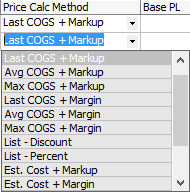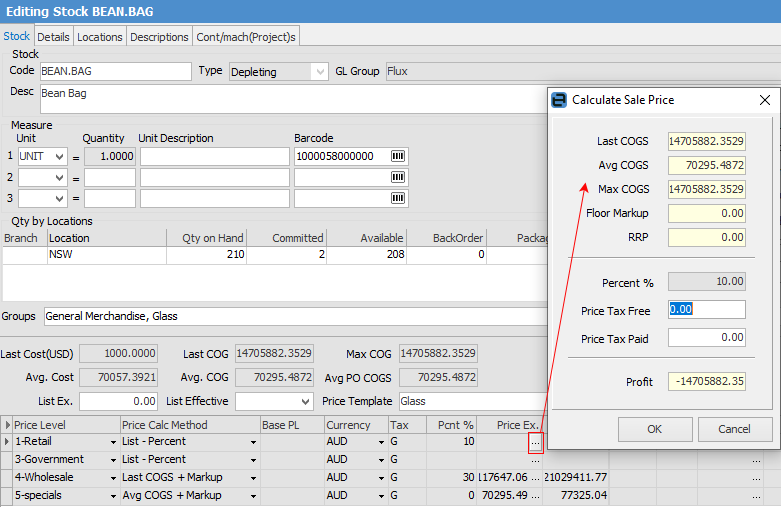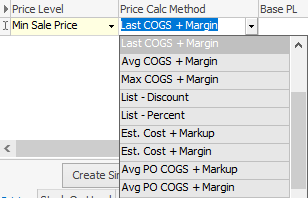

You will need to add each Price Level code to the grid and the Card Code of anyone you want to give special pricing to. The available Price Calculation Methods are shown here.
When adding pricing to your stock records, the Price Calc Method that is first used (the default), will be the one that you have already set in Tools > Options > Stock > Stock Pricing. If required, you can override the default method for any or all of the Stock Price Levels you choose. Regardless of which Price Calc. Method you select, you can type either a percentage amount, or a dollar value into the relevant price grid field, and the other field will be automatically updated. For example, if the list price (ex) is $200.00, and you select List – Percent (List price minus a percentage) as the Price Calc Method, then you would normally enter a value in the Pcnt % column (say 10%), which will then set the dollar amount in the Price Ex. column in this case to $180.00. However, if you prefer, you could instead enter a whole dollar amount in the Price Ex. field (say $175.00), which will automatically set the Pcnt % value.
Any calculated Price Ex. amount will round itself to the nearest Rounding Amount set in Tools > Options > Stock > Stock Pricing (Round sale price to nearest xx cents).
|
If a specific customer is nominated in the Price Level grid, each job for that customer which uses that stock will attract the special price and price breaks automatically. To indicate that special prices apply, the job stock grid line on that customer's job will be shown on a green background, as shown in this example.
 |
Within the Price Level grid, you can select either a minimised or expanded view, by selecting the arrow  in the top left corner of that grid. Expanded is the default view each time Jim2 is first opened.
in the top left corner of that grid. Expanded is the default view each time Jim2 is first opened.
If you use the List – Percent (list price minus a percentage), there's an ellipsis [...] which, when you select that field, shows what is used for recalculating the list pricing levels if you have had to change the list value.

The pricing entered is based upon your Base Unit Measure. By default, when you view the Transaction tab in a stock record, the grid will default to show the pricing based on your base selling unit (typically UNIT). You can use the drop-down list located above the pricing grid to switch between your different unit measures to view the selling price of those units instead. This is for viewing purposes only. Your selection on a stock record will have no bearing on how it's sold, purchased, or reported on.
Shown below is the stock grid view. To enter Tax Free prices, you will need to select the ellipsis [...] within the Price Ex. field to access the Calculate Sale Price screen. You must be in Edit mode to do this

Field |
Purpose |
|---|---|
Price Level |
Add a Price Level code from the drop-down list. Select the required code: 1-Wholesale, 4-Retail, etc. or choose Min Sale Price or Specific customer price.
Note: You can set security to allow/not allow to sell stock for less than min price. |
Tax |
The Tax code for this stock. |
Price Ex.* |
Add the Tax Free selling price of each unit measure. |
>= Qty |
Add the Qty of the first price break (eg. 10 or greater). |
Price Ex.* |
Add the Tax Free selling price of each unit in the first price break. |
>= Qty |
Add the Qty of the second price break (eg. 20 or greater). |
Price Ex.* |
Add the Tax Free selling price of each unit in the second price break. |
>= Qty |
Add the Qty of the third price break (eg. 30 or greater). |
Price Ex.* |
Add the Tax Free selling price of each unit in the third price break. |
>= Qty |
Add the Qty of the fourth price break (eg. 40 or greater). |
Price Ex.* |
Add the Tax Free selling price of each unit in the fourth price break. |
|
The Price Ex. field referred to in the table above assumes that you have selected Show Tax Free Pricing in Price Grid Display in Tools > Options > Stock > Stock Pricing. If you have selected to Show Tax Paid Pricing instead, then Price Inc. fields will be displayed. Note that both the Price Ex. and Price Inc. fields are displayed in the expanded view (see table below). |
The expanded stock grid shows the fields below (note: expanded is the default view).
Field |
Purpose |
|---|---|
Price Level |
Add the Price Level code: Retail, Wholesale, etc. Select the required code, or enter the Price Level number. |
Price Calc Method |
The used method for price calculation. Make a selection from the drop-down list. |
Tax |
The Tax Type, eg. G for GST. |
Pcnt % |
Percentage of Markup. |
Price Ex. |
Add the Tax Free selling price of each unit measure. |
Price Inc. |
Calculated Tax Paid selling price of each unit measure. |
>= Qty |
Add the Qty of the first price break (eg. 10 or greater). |
Pcnt % |
Percentage of Markup. |
Price Ex. |
Add the Tax Free selling price of each unit in the first price break. |
Price inc. |
Calculated Tax Paid selling price of each unit in the first price break. |
>= Qty |
Add the Qty of the second price break (eg. 20 or greater). |
Pcnt % |
Percentage of Markup. |
Price Ex. |
Add the Tax Free selling price of each unit in the second price break. |
Price Inc. |
Calculated Tax Paid selling price of each unit in the second price break. |
>= Qty |
Add the Qty of the third price break (eg. 30 or greater). |
Pcnt % |
Percentage of Markup. |
Price Ex. |
Add the Tax Free selling price of each unit in the third price break. |
Price inc. |
Calculated Tax Paid selling price of each unit in the third price break.. |
>= Qty |
Add the Qty of the fourth price break (eg. 40 or greater) |
Pcnt % |
Percentage of Markup. |
Price Ex. |
Add the Tax Free selling price of each unit in the fourth price break. |
Price inc. |
Calculated Tax Paid selling price of each unit in the fourth price break. |
|
Jim2 pre-calculates and stores all pricing in real time, as pricing changes. This allows immediate and easy updating of Websites, Price Lists, and bulk price updates, to name just a few. |
If you have no Qty in Stock, but have set up a Vendor Stock Code and Cost in the Vendor's Tab, that will be used for Pricing Calculations.
Min Sale price level allows you to use any of the Jim2 pricing calculation methods to set the minimum sale price, instead of just a nominated price. For example, you could set it to Average PO cost + 5%, thereby ensuring that nobody sells for less than cost plus 5%.

Explanation of Price Background Colours
White |
Price level pricing. |
Pink |
Contract price level pricing. |
Green |
Customer specific pricing. |
Yellow |
Manually entered pricing. |
Further information:
